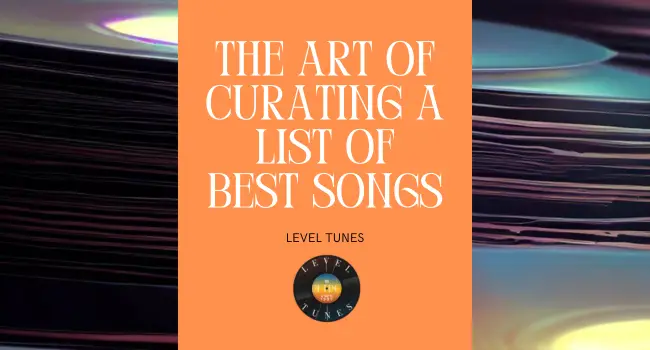The Art Of Curating A List Of Best Songs
There’s something about curating a list of the best songs that feels incredibly intimate. It’s as if you’re sharing a part of yourself with others, revealing your deepest musical loves and influences.
But crafting such a list is no easy task – it requires careful consideration, an ear for quality, and an ability to capture the essence of what makes each song great.
As a music curator myself, I understand the importance of creating a cohesive and meaningful collection of songs. Whether it be for personal enjoyment or public consumption, selecting the right tracks can make all the difference in how they are perceived by listeners.
In this article, we’ll explore some tips and tricks on how to curate your own list of best songs – from understanding your audience to finding hidden gems within different genres.
So grab your headphones and let’s get started!

Defining Your Criteria
As a music curator, the first step in creating a list of best songs is to establish your standards. What makes a song great? Is it its popularity, technical proficiency or lyrical depth? Understanding what you value most in music will help guide your selection process.
Personal preferences also play an important role when curating your list. While it’s essential to consider popular opinion and critical acclaim, ultimately, your list should reflect the music that resonates with you.
Another crucial factor to consider when building your list is historical significance and cultural relevance. Songs that have stood the test of time or made significant contributions to musical movements are worth including on any curated playlist.
Additionally, incorporating genre diversity ensures that listeners experience different sounds and styles while still maintaining coherence throughout the playlist. By thoughtfully considering these criteria, you can create a well-rounded and meaningful collection of songs that reflects both your personal taste and broader cultural context.

Researching Popular Songs
As a music curator, researching popular songs is an essential part of my job. It allows me to discover new artists and tracks that I may have missed otherwise. When looking for the most popular songs, there are several factors to consider, such as genre preferences, top streaming platforms, collaborative playlists, global vs. regional hits, and the impact of social media on song popularity.
Firstly, understanding different genre preferences is crucial when researching popular songs. Each genre has its fan base and unique listening habits. For example, if you’re curating a pop playlist, you will need to look at what’s trending in the pop charts across various regions worldwide.
On the other hand, if it’s hip-hop or RnB that you’re interested in exploring, then your focus should shift towards urban music blogs and podcasts. Secondly, we cannot ignore the influence of top streaming platforms like Spotify and Apple Music when determining which songs are making waves globally. These platforms offer valuable insights into what people are currently listening to by providing daily updated charts of their most-streamed songs.
Finally, collaborative playlists created by users on these streaming platforms can also provide useful information about emerging trends in music consumption. By analyzing these playlists’ content and structure (i.e., how often certain genres appear), curators can gain insight into current tastes and styles within specific demographics.
In conclusion, researching popular songs requires paying attention to multiple variables while keeping an eye out for emerging trends in music consumption patterns. As a result of this research process comes carefully curated lists of best songs that reflect the cultural zeitgeist accurately.
Analyzing Music Theory
As a music curator, one of the most important aspects to consider when analyzing songs is their music theory. It’s like peeling back layers of an onion – each layer revealing more depth and complexity. Melodic tension, harmonic complexity, rhythmic variation, tonal ambiguity, and lyrical depth all come together to create a sonic landscape that can evoke emotion in listeners.
Let’s take a closer look at these elements by breaking them down into a table:
| Music Theory Element | Definition |
|---|---|
| Melodic Tension | The contrast between two or more melodies within a song |
| Harmonic Complexity | The use of non-traditional chords or chord progressions |
| Rhythmic Variation | The deliberate alteration of rhythm patterns throughout the song |
| Tonal Ambiguity | When the key signature or tonality is not clearly defined |
When assessing melodic tension, it’s essential to analyze how different melodies interact with each other. For example, does the chorus melody complement or clash with the verse melody? Meanwhile, harmonic complexity refers to using unconventional chord progressions as opposed to basic triads commonly found in pop music. This creates dissonance and adds richness to the overall sound. Lastly, tonal ambiguity challenges traditional notions of major/minor keys and instead uses notes from multiple scales creating an ambiguous feeling for the listener.
Incorporating these elements into our analysis helps us appreciate just how much effort goes into crafting great songs. From its catchy hook to its intricate harmonies and poetic lyrics – it takes true artistry to make something memorable.
Reading Reviews
As we’ve explored in the previous section, analyzing music theory is a crucial step towards understanding and appreciating any piece of music. However, it’s not just about the technical aspects; curating a list of best songs also requires expert opinions, critical analysis, user ratings, cultural significance, and subjective taste.
When it comes to selecting the best songs from a particular genre or time period, there are many factors at play. For instance, one song might be highly rated by users but lack cultural significance or vice versa. As a music curator or critic, it’s essential to strike a balance between these different elements while keeping your own personal preferences in mind. Ultimately, the goal is to create a playlist that captures the essence of that particular era or style while appealing to a broad range of listeners.
As you move on to reading reviews in the next section, keep in mind that they can provide valuable insights into what makes certain songs stand out. However, don’t let them overshadow your own subjective taste and instincts as a listener.
Remember: at its core, curation is an art form that requires both expertise and intuition. So whether you’re putting together a playlist for yourself or sharing with others, trust your instincts and have fun exploring all the different facets of music!

Crafting Your Final List
Crafting your final list of best songs is a task that requires careful consideration and attention to detail.
As a music curator or critic, it’s important to keep in mind the personal preferences of both yourself and your audience. While it may be tempting to simply include all of your favorite songs on the list, it’s crucial to also consider the tastes and interests of others.
One way to ensure a well-rounded and diverse selection is through collaborative efforts. By seeking input from other music enthusiasts, you can gain new perspectives and insights into different genres or artists that you may have overlooked.
Additionally, considering historical significance and cultural relevance can add depth and meaning to your final list. After all, music has always been an integral part of human history and culture, so including songs that represent significant moments or movements can create a more impactful listening experience for your audience.
Ultimately, crafting a final list of best songs should be approached with care and intention – incorporating personal preferences, diversity across genres, collaboration with others, as well as historical and cultural significance will result in a truly memorable collection.
Frequently Asked Questions
How Do You Determine The Target Audience For Your List Of Best Songs?
Determining the target audience for a list of best songs requires thorough demographic analysis, genre preference research, understanding regional popularity, assessing occasion relevance, and determining platform suitability.
As a music curator or critic, it’s important to consider these factors in order to create a playlist that resonates with your intended audience. By analyzing demographics such as age, gender, and location, you can tailor the playlist to their tastes and preferences.
Genre preference is also crucial – some may prefer pop hits while others are more inclined towards indie or alternative genres. Regional popularity should be considered when selecting songs that will resonate with listeners from specific areas.
Additionally, considering the occasion for which the playlist is being curated (such as a party or workout session) is necessary to ensure its relevance and appeal. Finally, it’s important to consider platform suitability – where will this playlist be shared? Will it be on streaming services like Spotify or Apple Music?
Understanding how people consume music through different platforms can help curate a successful list of best songs that truly connects with the desired audience.
Should You Include Songs From Lesser-Known Artists Or Stick To Well-Known Hits?
When crafting a playlist, it’s easy to fall into the popularity trap. But as a music curator, it’s important to balance quality with mass appeal.
Including lesser-known artists can lead to discovering gems that bring new flavors and perspectives to your list. Giving these up-and-comers a chance not only diversifies your selection but also helps support their growth in the industry.
Of course, one shouldn’t discount well-known hits altogether – they’re popular for a reason! However, with streaming services providing endless options at our fingertips, there’s no excuse not to seek out fresh talent while still maintaining an enjoyable listening experience.
How Do You Balance Personal Taste With Objective Analysis When Selecting Songs?
When it comes to selecting the best songs, one must be able to balance personal preferences with objective criteria.
It’s easy to fall into the trap of only including well-known hits or trendy tracks, but genre diversity and timelessness should always be considered.
Emotional impact is also crucial in creating a list that resonates with listeners on a deeper level.
As a music curator, I believe that finding the right balance between subjective taste and objective analysis requires careful consideration and an open mind.
Ultimately, the goal is to create a playlist that not only showcases great music but connects with people on a meaningful level.
What Is The Best Way To Organize Your List Of Best Songs?
When organizing your list of best songs, it’s important to consider a few key ranking criteria.
First and foremost is genre diversity – you want to make sure that your playlist has a balance of different styles and sounds.
It can also be helpful to collaborate with others in the curation process, as this can bring fresh perspectives and ideas to the table.
When selecting songs, it’s important to strike a balance between timelessness and trendiness – while it’s great to include current hits, you also want to make sure that your playlist will stand the test of time.
Finally, don’t forget about international representation – including music from different cultures and regions can add depth and richness to your list.
With these considerations in mind, you’ll be well on your way to crafting an unforgettable playlist.
Should You Consider The Historical And Cultural Significance Of A Song When Selecting It For Your List?
When selecting songs for your list, it’s essential to consider the cultural relevance, historical significance, social context, musical influence, and political implications of each track.
As a music curator or critic, it’s not enough to pick popular songs; you also need to examine how they fit into broader societal conversations. For example, think about how certain genres have evolved over time and how different artists have shaped them.
Additionally, ask yourself whether a song has any political undertones that could resonate with listeners today. By taking these elements into account when creating your playlist, you’ll create something truly special – one that resonates with audiences on multiple levels while highlighting the best music out there!
All in All
In conclusion, curating a list of best songs requires a delicate balance between personal taste and objective analysis.
As a music curator, it is important to consider the target audience for your list and whether to include lesser-known artists or stick to well-known hits. However, ultimately the most important factor should be the quality of the song itself.
When organizing your list, there are various approaches you can take such as arranging by genre or chronology. Additionally, considering the historical and cultural significance of a song can add depth and context to your selections.
The art of curating a list of best songs is not easy but with careful consideration and attention to detail, you can create a playlist that will resonate with your audience and stand the test of time.
Thanks for reading.
TBone




